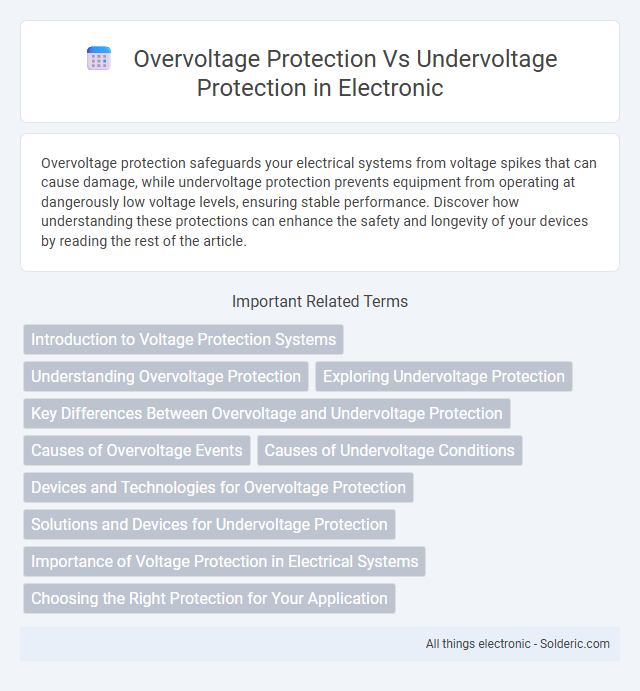Overvoltage protection safeguards your electrical systems from voltage spikes that can cause damage, while undervoltage protection prevents equipment from operating at dangerously low voltage levels, ensuring stable performance. Discover how understanding these protections can enhance the safety and longevity of your devices by reading the rest of the article.
Comparison Table
| Feature | Overvoltage Protection | Undervoltage Protection |
|---|---|---|
| Purpose | Prevents damage from voltage exceeding safe limits | Prevents device malfunction due to voltage dropping below safe levels |
| Trigger Voltage | Voltage > Upper threshold | Voltage < Lower threshold |
| Common Devices | Surge protectors, voltage clamps, TVS diodes | Undervoltage relays, voltage monitors, brownout protectors |
| Typical Applications | Power supply lines, sensitive electronics, industrial equipment | Motors, power supplies, battery-operated devices |
| Protection Mechanism | Clamps excess voltage, disconnects or limits power | Shuts down equipment or alerts when voltage is insufficient |
| Importance | Prevents damage from spikes, surges, lightning | Prevents instability, improper function, equipment failure |
Introduction to Voltage Protection Systems
Voltage protection systems safeguard electrical equipment by regulating voltage levels to prevent damage caused by abnormal conditions. Overvoltage protection devices detect and mitigate voltage spikes exceeding the standard operating range, ensuring equipment safety from transient surges and power surges. Undervoltage protection mechanisms monitor voltage drops below acceptable thresholds, preventing malfunctions and operational failures in sensitive electrical components.
Understanding Overvoltage Protection
Overvoltage protection safeguards electrical systems from voltage spikes exceeding normal operating limits by using devices like surge protectors, voltage clamping components, or crowbar circuits. These protective measures prevent damage to sensitive equipment, reduce the risk of fire, and ensure system reliability. Understanding overvoltage protection is crucial in industrial controls, power supply design, and consumer electronics to maintain stable voltage levels and extend component lifespan.
Exploring Undervoltage Protection
Undervoltage protection safeguards electrical equipment by detecting voltage drops below a preset threshold, preventing malfunctions and damage caused by insufficient power supply. This protection is crucial for maintaining the stability of motors, transformers, and sensitive electronics, ensuring they operate within safe voltage limits. You can enhance system reliability by integrating undervoltage protection devices that automatically disconnect or shut down equipment during voltage sags or interruptions.
Key Differences Between Overvoltage and Undervoltage Protection
Overvoltage protection safeguards electrical devices by limiting voltage surges that exceed the maximum threshold, preventing insulation damage and equipment failure. Undervoltage protection detects voltage drops below a specified limit, ensuring machinery operates within safe voltage ranges to avoid malfunction or inefficiency. Key differences include the operational voltage thresholds they monitor and the specific risks mitigated, with overvoltage protection focusing on excessive voltage spikes and undervoltage protection addressing insufficient voltage levels.
Causes of Overvoltage Events
Overvoltage events are primarily caused by lightning strikes, power surges from switching operations, and sudden load rejections in electrical systems. These incidents can lead to severe damage to your electronic equipment by exceeding the voltage rating, resulting in insulation failure and component breakdown. Implementing overvoltage protection alongside undervoltage protection ensures comprehensive safeguarding of your electrical devices against voltage fluctuations.
Causes of Undervoltage Conditions
Undervoltage conditions typically arise from excessive load demand, faulty wiring, or issues with the power supply such as grid instability or transformer failures. These conditions can lead to insufficient voltage levels, causing equipment malfunction, reduced efficiency, and potential damage. Effective undervoltage protection systems detect these voltage drops promptly to prevent operational disruptions and safeguard electrical components.
Devices and Technologies for Overvoltage Protection
Devices for overvoltage protection include surge protectors, metal oxide varistors (MOVs), transient voltage suppression (TVS) diodes, and gas discharge tubes that safeguard electrical systems by clamping voltage spikes. Technologies such as crowbar circuits and thyristor voltage suppressors quickly divert excess voltage away from sensitive components, preventing damage. These solutions are essential in power supply units, telecommunications, and industrial control systems to ensure stable operation during transient overvoltage events.
Solutions and Devices for Undervoltage Protection
Undervoltage protection solutions primarily include voltage monitoring relays, undervoltage sensors, and automatic transfer switches that ensure your equipment operates within safe voltage limits to prevent malfunction or damage. Devices such as undervoltage releases integrated into circuit breakers can disconnect power when voltage drops below a set threshold, safeguarding motors and sensitive electronics. Implementing these devices maintains system stability by detecting low voltage conditions and initiating protective responses before equipment failure occurs.
Importance of Voltage Protection in Electrical Systems
Voltage protection is critical in electrical systems to prevent damage caused by fluctuations beyond safe operating limits. Overvoltage protection safeguards equipment from excessive voltage spikes that can cause insulation failure or component burnout, while undervoltage protection ensures devices operate within minimum voltage levels to avoid malfunction or instability. Your electrical system's reliability and lifespan depend on the precise implementation of both overvoltage and undervoltage protection mechanisms.
Choosing the Right Protection for Your Application
Selecting the right protection for your application depends on the specific voltage risks your system faces. Overvoltage protection safeguards devices from voltage spikes that can cause immediate damage, while undervoltage protection ensures stable operation by preventing performance issues due to low voltage conditions. Understanding your equipment's tolerance and operating voltage range helps you implement the most effective protection method for reliability and safety.
Overvoltage protection vs Undervoltage protection Infographic

 solderic.com
solderic.com